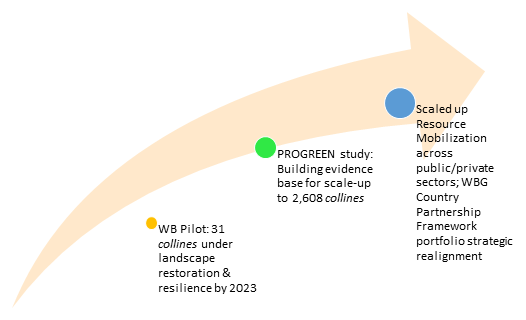Building resilience in the land of 3,000 collines: Rooting out drivers of climate fragility in Burundi
By Juergen Voegele, Veronique Kabongo and Arame Tall
When you land in Bujumbura, Burundi, you are immediately struck by the verdant landscape. Everything is green. The peaceful city is surrounded by beautiful Lake Tanganyika, the deepest in Africa, with majestic hills to the north. Soon, one discovers that those steep hillsides, the nearly 3,000 or so “collines” of Burundi, are much more than an extraordinary landscape. They are home to a patchwork of communities organized around each colline. In many ways, they represent the beauty but also the pains of the people who live on it and from it. These collines hold the souls of ancestors and families lost during past conflicts, including the 1994 crisis. They tell the country’s story.
But this impressive majestic landscape is threatened by overuse and degraded resources which are further aggravated by climate change. Climate-related disasters—chiefly torrential rains, floods and landslides—have triggered 100% of the forced displacements in 2020 in Burundi according to the United Nations Office for the Coordination of Humanitarian Affairs, underscoring the urgency of action to address compounded risks from rising climate impacts, fragility, and displacement.
Multi-risk vulnerability in Burundi’s colline landscapes
Like many African countries, Burundi is set to bear the brunt of impacts from climate change that it was not responsible for creating. Globally, Burundi has the lowest per capita Greenhouse Gas emissions, ranking last out of 188 countries and contributing only 0.01% to global emissions. Meanwhile, Burundi is extremely vulnerable to the impacts of climate change and faces the burden of the impacts of global emissions, ranking 171 out of 181 countries in the Notre Dame Global Adaptation Index, which summarizes countries’ vulnerability to climate change.
Furthermore, each year, Burundi loses almost 38 million tons of soil and 4% of its gross domestic product (GDP) to land degradation. The coffee sector exemplifies people’s dependence on natural resources for their livelihoods: half of the country’s households live off the sector which brings 90% of the country’s foreign revenue. But in the last 40 years, severe soil erosion led to a two-thirds decrease in coffee production, pushing millions back into poverty.
Burundi’s collines are home to more than 90% of the country’s largely rural population, composed of mostly women and youth, who rely on agriculture and forestry for their livelihoods. They also are critical hubs of multi-risk vulnerability: 75% of court cases are linked to land disputes, and the recent massive return of refugees from neighboring Democratic Republic of Congo, Rwanda and Tanzania has been a source of increased conflict and violence. Poverty and conflict in Burundi are closely linked to resource dependence and climate fragility. Since 2015, the country has experienced unprecedented forced displacement: 131,000 internally-displaced people were counted in 2020, 83% of whom were driven by climate-related disasters and 17% caused by other socio-economic factors, according to the International Organization for Migration Displacement Tracking Matrix.
In Burundi’s context, climate change compounds pre-existing risks through rising rainfall and temperature variability, projected to worsen by 2030-50, with recurrent flooding, landslides and soil erosion already destroying livelihoods and exacerbating poverty. Past extreme weather events including severe floods in 2006 and 2007 and severe droughts between 1999 and 2000 and in 2005 accounted for losses exceeding 5% of the GDP, affecting more than two million Burundians. In addition, river flooding from Lake Tanganyika poses an increasing challenge. Batwa communities are particularly disenfranchised, and at the heart of multi-sector vulnerability, making community-driven development approaches critical in Burundi’s development context.
Climate change is the ultimate threat multiplier in fragile and conflict-affected states such as Burundi. Institutions unprepared to face new environmental and climate risks, high levels of poverty, and agricultural-based economies make them particularly vulnerable.
The Bank’s response to build foundations of resilience in Burundi’s collines
The World Bank has been engaged in Burundi for many years and continues through a deliberate strategy to mainstream climate resilience across all sectors. A series of World Bank-financed projects have supported the government’s efforts to build resilient ecosystems and livelihoods. The $4.2 million Coffee Landscapes Project transformed Burundi’s fragile environment by addressing the causes and consequences of land degradation. The approaches piloted were replicated and scaled up in the $55 million Coffee Competitiveness Project, the $30 million Landscape Restoration and Resilience Project and the $6 million Global Environment Facility Additional Financing. Together, they sustain the efforts by extending system-level landscape restoration, terracing works, and community livelihood resilience activities. These include land certification for vulnerable groups with 50% going to women farmers. A total of 192,117 hectares of degraded lands in 31 collines will be put under integrated landscape management practices by 2023.
However, 2,608 more collines are still degraded and will need to be restored to increase agricultural and pastoral productivity, and to build their resilience to current and future climate risks. The World Bank has committed to scale up activities nation-wide to cover all collines, starting with a study funded by PROGREEN, a global partnership promoting resilient landscapes. The new Burundi government has committed to invest more in driving out the root causes of degradation and fragility on all collines and lists climate change as one of its strategic priorities.
Figure 1: Scaling up Investment into Burundi’s Colline Landscapes

Source: The World Bank
This is mission possible, but it cannot be done alone. While the World Bank is mobilizing additional resources through its Prevention and Resilience Allocation, it is essential to crowd-in financial and technical partners, including United Nations’ agencies and other climate concessional financing.
Addressing climate risks in fragile states has the potential to enhance resilience and reduce sources of conflict, while generating growth and long-term sustainable development. To be effective, climate investments must recognize the interlinkages between climate and conflict risks. In Burundi as in every other country, these investments must also be rooted in strong political and institutional support to trigger the changes needed to make the “land of 3,000 collines” resilient.